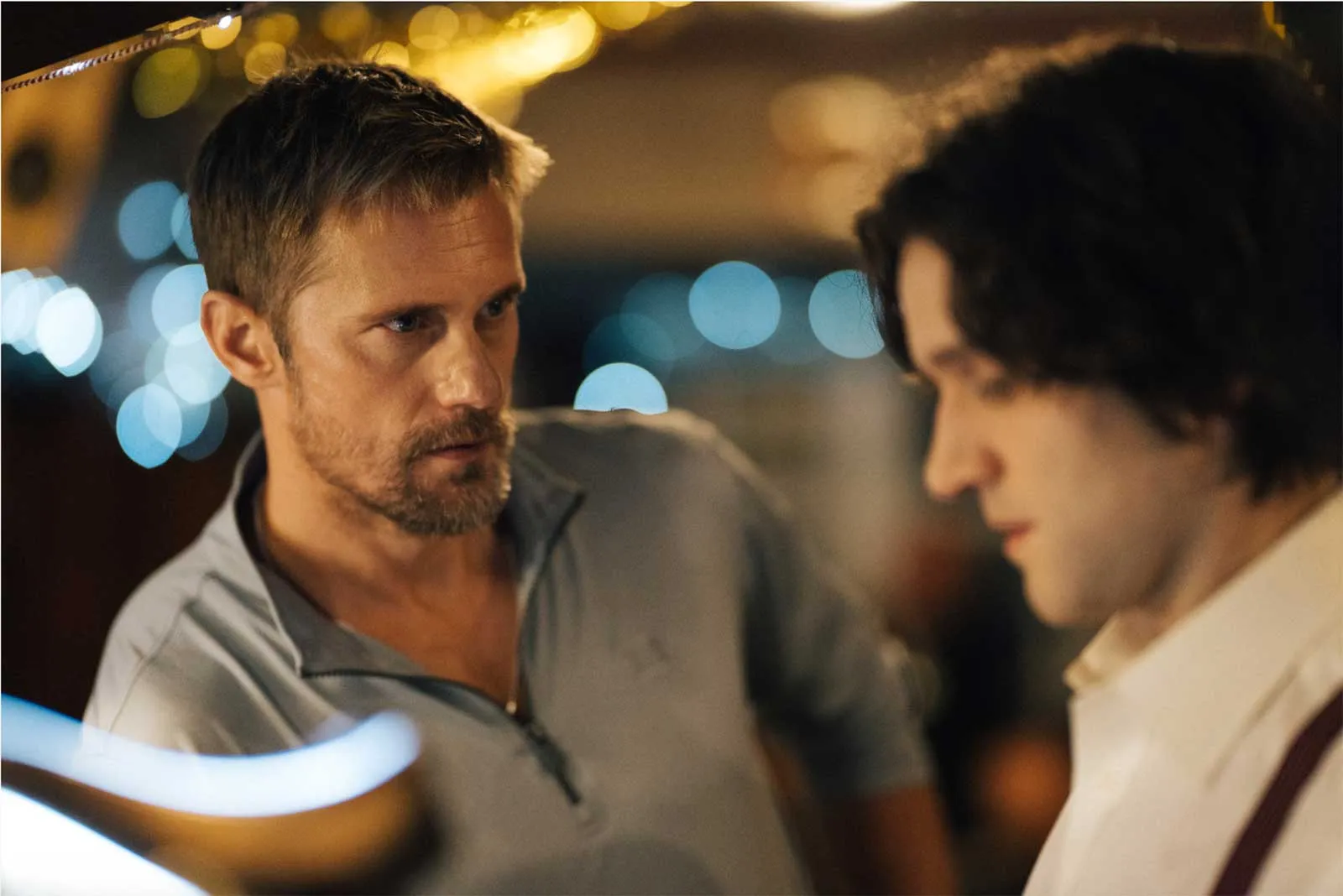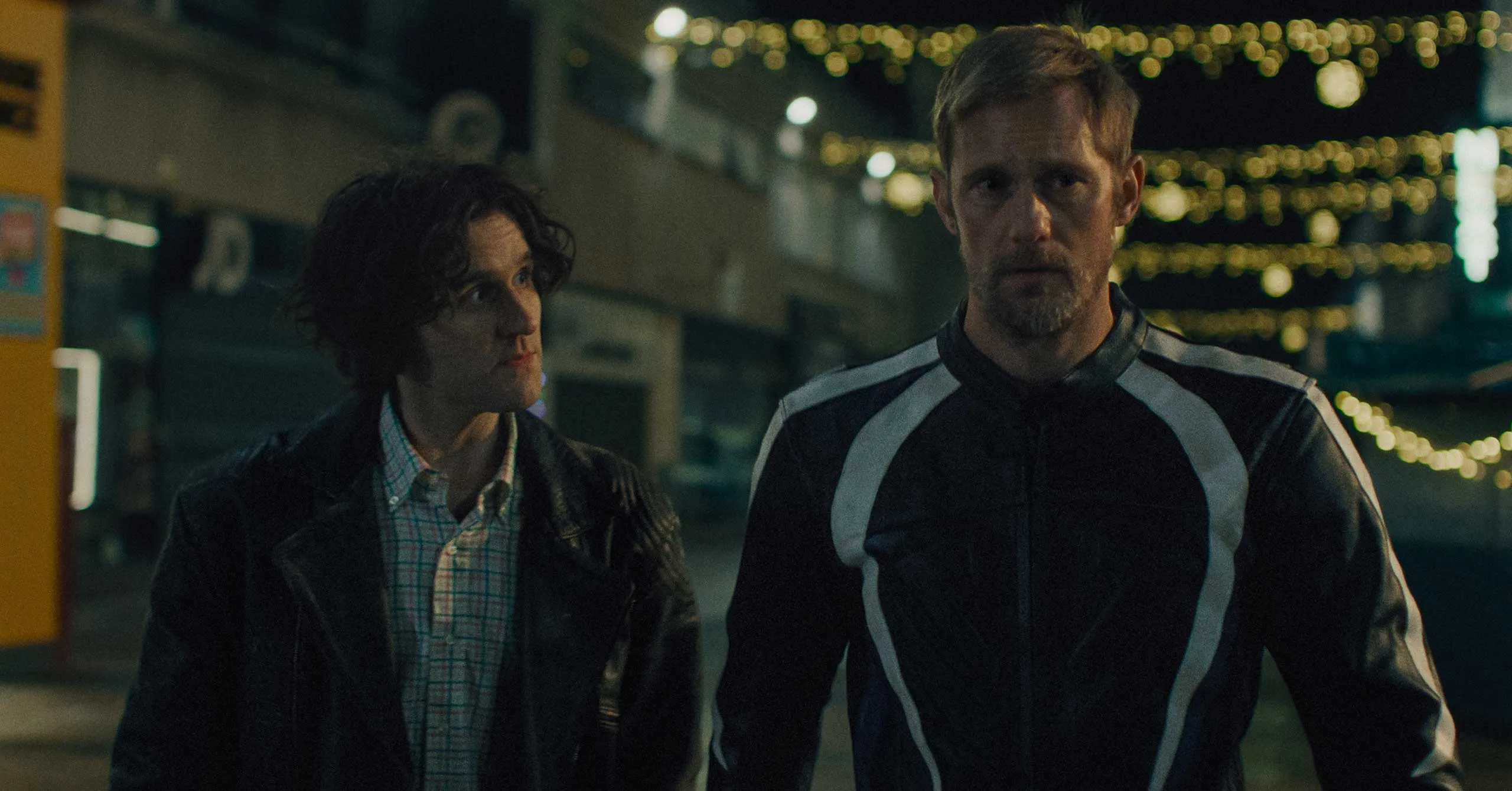Harry Melling and Alexander Skarsgård as Colin and Ray in Harry Lighton’s Pillion. Courtesy of Element Pictures
Harry Melling and Alexander Skarsgård as Colin and Ray in Harry Lighton’s Pillion. Courtesy of Element Pictures
We spoke to costume designer Grace Snell about how she created Alexander Skarsgård and Harry Melling’s wardrobe for A24’s Pillion.
Grace Snell never set out to become a costume designer. “I think, like many things, it happened by accident. I didn’t even know it was a job,” she admits from London, fresh off the set of the latest Sense & Sensibility adaptation starring Daisy Edgar-Jones and George MacKay. Since then, her career has taken her from dressing music videos to directing global advertising campaigns and shaping the visual world of acclaimed films and series such as The Souvenir, Mogul Mowgli, I Hate Suzie, The Outrun, and the A24 feature Pillion, featuring Alexander Skarsgård and Harry Melling. For Pillion, she sourced and custom-designed biker and fetishwear, a project that earned her the British Independent Film Award for Best Costume Design.
Taking a closer look at her beginnings, her path begins to feel almost inevitable. In Norwich, a UNESCO City of Literature known as the birthplace of the postcode and the home of Colman’s Mustard, Grace grew up dressing in costumes handmade by her Nanny. She had been a machinist at Nurseys in the 1960s and 1970s, crafting sheepskin hats, gloves, slippers, and coats, the very pieces Derek “Del Boy” Trotter later immortalised in Only Fools and Horses, the UK’s most popular BBC series of all time, second only to David Attenborough’s Planet Earth.
At school, she knew she wanted to pursue a degree that would let her learn a skill, initially dreaming of becoming a painter or sculptor. While completing her Art Foundation at Camberwell College of Art, she realised her fascination wasn’t simply with colour or composition but with people, their stories, and the symbolism carried in clothing. When a tutor encouraged her to explore costumes, “a whole world opened up that I just did not know existed.” She went on to take a BA in Theatre Design at Wimbledon College of Art, another institution under the umbrella of the University of Arts London.
Snell’s anthropological awareness has shaped her personal identity. She remembers working with Tilda Swinton and her daughter Honor Swinton Byrne on The Souvenir, and how she felt supported and encouraged in her design choices. “She’s very inquisitive, curious, open-minded, and collaborative. She clearly knows herself when it comes to her body and style.” Collaborations with Swinton, Saoirse Ronan, and Billie Piper have been central to her creative development. “That’s a real influence for me because you can genuinely collaborate with the actor.”

The way costumes reverberate beyond the screen is something she has witnessed. In The Souvenir, she used a collection of 1980s Turnbull & Asser shirts for Tom Burke. Months later, she discovered the brand’s creative director Becky French, had used the costumes on the moodboard. “That is a 360 moment,” she confesses. Around the same period, during I Hate Suzie, she realised something had shifted in the cultural appetite for costume. “The world went into lockdown,” she says. “Everyone got obsessed with TV. And it became such escapism.” With viewership booming, she sensed a hunger for detail. “Something has shifted, and costume design is influencing trends more.”
Connection and deep research became essential for Pillion, Harry Lighton’s adaptation of Adam Mars-Jones’s Box Hill. The script arrived through producer Emma Norton. Reading it was a jolt. “I hadn’t read anything like that before, which was really intriguing and interesting and exciting,” she says. Lighton was immediately energized by what her perspective, “a sort of straight female,” might bring to the material. For Snell, the unfamiliarity was the challenge she craved. “I always want to challenge myself and learn. I don’t ever want to be comfortable in what I design.”
Snell began her research in two directions. First, the bikers themselves. She grew up near large ride-outs and returned that summer with a notebook and a camera. “I was photographing a lot and chatting to them all about more practical things, why they wear certain things, why they’re loyal to a certain brand, what colours they like to wear. And then what looks a bit sexy and striking visually.” She paid close attention to subtleties: the way certain jackets break in, why boots crease the way they do, and the pride of battle scars.
Her second exploration took her into the subtle realms of fetish culture. “That’s quite secretive,” she remarks. “Talking to a few people, it’s much more word of mouth. So I was keeping a journal and writing things down.” Her research covered topics from Murray Healy’s Gay Skins: Class, Masculinism and Queer Appropriation to how materials like latex, leather, and even socks become fetishized. She found that clothing is not just functional or expressive, but tailored to individual kinks. “Everything is so personal. There’s no one-size-fits-all. We grow every year, we change what we like. I learned that I can’t fit anything in a box. Everything has to be fluid, even in how I design.”
Nothing off the rack fit Alexander Skarsgård’s proportions. “He’s not the standard size,” she says. The problem became an opportunity. Snell reached out to Hideout Leather, a covert legend in the film industry run by a craftswoman named Kate Jennings. “She just got really, really excited and wanted to be on board,” Snell recalls. Together they built two full sets of leathers: one for riding, another for fetish. The latter included the black braces-style salopette with a full under-zip. “It’s fetish wear,” she notes, appearing in Ray’s private scenes of control.

Snell’s boldest choice was color. Skarsgård arrived expecting black; instead, Snell presented cream leather. “I think he was a bit shocked,” she says, laughing. But the reasoning was poetic. “I love this idea of him being like this knight in shining armor. We’re going to be shooting so much at night. I wanted to be able to see him—and him to look like he’s on a pedestal.” The result reimagines the traditional leatherman archetype as both mythic and contemporary, while maintaining the practical benefits of reflecting sunlight and absorbing less heat.
Colin, played by Harry Melling, is shaped through contrast. Snell designed him as someone who has never dressed for himself. “We get the sense that Colin doesn’t ever choose any of his clothing himself.” His mother irons his shirts, washes his pants, redecorates his life into safe neutrality. His work uniforms, first in a barbershop quartet, then as a traffic warden, flatten him further. Even on his first date with Ray, he wears “a brown leather jacket that he’s borrowed from his dad.” His visual identity is almost erased.
“Ray is choosing what he wants him to wear,” Snell says. The leathers and erotic textures all signal Colin’s submission. Before she dressed a single actor, Snell convened a panel to ask everyone what they were comfortable with, a layer of consent woven beneath the costumes themselves. The more Ray controls, the more distinct Colin’s look becomes, not because he is choosing who he wants to be, but because someone else is choosing it for him. Snell is careful not to reveal the film’s ending. “We don’t really get a sense of Colin owning who he is until the end.”
Designing the pillions, the passengers, became one of her favorite challenges. Each biker essentially styled their own partner. “All the bikers have dressed them how they would want, what they find attractive and sexy,” she explains. Much of the leather was sourced secondhand, from eBay, Facebook Marketplace, charity shops, or even borrowed from the actors themselves. Snell takes pride in this approach: “I try to buy secondhand as much as I can.”
What she learned from Pillion extends beyond the screen, giving her a deeper, more nuanced understanding of sexuality. “I learned a lot about consent, desire, how we can be better, how to be less judgmental, how to be more open-minded.” She hopes that audiences leave with a sense of curiosity toward their own interior lives. “I’d love us to come away and be like we can all be like Colin when it comes to sexuality and testing our upper limit and exploring our fantasies.”
- “Costume Art” Is the First Exhibition in the Costume Institute’s New Permanent Galleries at The Met
- Vogue Exclusive: Behind the Costumes of ‘Wicked’ with Paul Tazewell
- Exclusive: The White Lotus Costume Designer Alex Bovaird on “Nudging the Audience” Through Clothing
- Pop Culture Costume Ideas You Might Already Have In Your Closet
